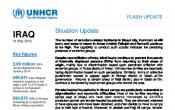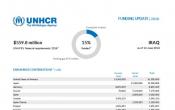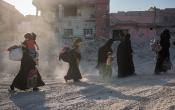Iraq
Operation: Iraq
Location
{"longitude":43,"latitude":33,"zoom_level":0,"iso_codes":"'IRQ'"}
By clicking on the icons on the map, additional information is displayed.
Key Figures
| 2017 year-end results | |
| 137,430 | internally displaced households received core relief items |
| 105,950 | IDPs were provided with legal assistance |
| 68,480 | Syrian refugees were provided with legal assistance |
| 27,890 | Syrian refugees received support for primary education |
| 21,160 | internally displaced households received multipurpose cash assistance |
| 2018 planning figures | |
| 200,000 | IDP and returnee families will receive core relief items |
| 120,000 | IDP and returnee families will receive cash grants |
| 115,000 | IDPs and returnees will receive legal assistance |
| 21,000 | Syrian refugee families will receive core relief items |
| 27,500 | Syrian refugees will receive legal assistance |
| 16,000 | Syrian refugee families will receive cash grants |
Latest Updates and Related Links
People of Concern
12%
Increase in
2016
2016
| 2016 | 5,326,166 |
| 2015 | 4,746,105 |
| 2014 | 4,026,863 |

[["Refugees",261888],["Asylum-seekers",11458],["IDPs",3604285],["Returned IDPs",1397016],["Returned refugees",157],["Stateless",48200],["Others of concern",3162]]
Loading ...
Iraq
< Back
2017
{"categories":[2013,2014,2015,2016,2017,2018],"budget":[293.72933672,564.26129787,556.06492208,546.94595405,557.093760866,559.82611683],"expenditure":[188.35476498,311.98260697,266.34543259,338.02568545,252.37669675,null]}
{"categories":[2013,2014,2015,2016,2017,2018],"p1":[182.85293216,162.76932396,136.09662109,116.48767369,137.52939031,135.89173072],"p2":[1.32216338,2.00000074,2.0459884,0.80424081,0.623739,0.307821],"p3":[27.30414868,39.59885527,35.76378805,26.70785472,null,null],"p4":[82.2500925,359.8931179,382.15852454,402.94618483,418.940631556,423.62656511]}
{"categories":[2013,2014,2015,2016,2017,2018],"p1":[131.81378143,109.08450058,102.03521415,98.77158239,78.07126444,null],"p2":[0.42206457,1.96887166,1.499491,0.30823717,0.26725107,null],"p3":[14.49497183,10.53576239,11.32961956,1.89021959,null,null],"p4":[41.62394715,190.39347234,151.48110788,237.0556463,174.03818124,null]}
Loading ...
CHOOSE A YEAR
- 2014
- 2015
- 2016
- 2017
- 2018
Operational context
Iraq continued to face multiple humanitarian crises with longstanding tribal and religious divisions further exacerbated by recent armed conflicts. The escalation of conflict during 2017 led to new waves of mass displacement, while successful government efforts to regain control of areas from extremist groups allowed for some returns to take place.Despite the Government of Iraq declared Mosul retaken in mid-July 2017 and the retaking of all Iraqi lands from the control of extremist groups in December 2017, some 2.6 million Iraqis remained internally displaced as of end 2017 according to IOM’s Displacement Tracking Matrix (DTM).
According to DTM, the number of people returning to their areas of origin surpassed the number of people being displaced inside the country in December. The majority of the more than 3.2 million people who returned to areas of origin since 2014 continued to face severely constrained access to basic services, security risks, extensive destruction of property and critical infrastructure, and lack of livelihood opportunities or financial resources. For many, this led to secondary or repeated displacement during 2017.
The needs of Syrian refugees in the Kurdistan region of Iraq, particularly those living outside of camps increased due to the persistently poor socio-economic situation and reduced livelihood opportunities. This decline in self-reliance resulted in an increased number of refugees seeking relocation to camps, in which absorption capacity remained limited.
Population trends
The IDP figures fluctuated throughout the year with the largest peak during the offensive to retake west Mosul from February to July 2017. According to the DTM, as of the end of 2017 there were 2.6 million IDPs in Iraq.There were more than 247,000 Syrian refugees registered in Iraq as of end December, with 97 per cent living in the Kurdistan region of Iraq. UNHCR recorded the arrival of more than 18,000 new Syrian refugees (57 per cent increase from 2016) in the Kurdistan region of Iraq, reflecting the worsening security situation in the Syrian Arab Republic (Syria). The majority of Syrian arrivals were admitted under a temporary visa regime with the exception of limited cases admitted on family reunification grounds. Over 12,000 Syrians spontaneously returned to Syria, out of which close to 9,900 people (more than 80 per cent) were registered with UNHCR.
Key achievements
- In April 2017, UNHCR rolled out the Comprehensive Household Assessment Tool (CHAT), a broad multi-sectoral assessment derived from the Protection Monitoring Tool (PMT) used for assessing the vulnerabilities of refugees. More than 138,000 internally displaced households were reached with the PMT and CHAT in 2017.
- UNHCR also applied the Assistance Information and Services Tracking System (ASSIST), and captured basic biodata for some 410,100 people. The implementation of the CHAT and ASSIST supported the effective implementation and delivery of core protection activities, including supporting the identification of vulnerable people and referral of cases for legal and other services.
- In 2017, UNHCR increased its unconditional and multipurpose cash assistance programme to allow IDPs to prioritize their needs while indirectly supporting the local economy. UNHCR provided a minimum of one multipurpose cash transfer to 21,160 families. Some 20 per cent of the families were identified as extremely vulnerable and received additional cash transfers.
- In response to displacements from Anbar and Ninewa, UNHCR constructed five camps for IDPs. The Office also supported returning families in Ninewa with close to 11,300 emergency shelter kits and 13,600 seal-off kits to upgrade conditions for people living in damaged and unfinished structures.
- In the Kurdistan region of Iraq, UNHCR distributed 5,255 tents for new arrivals and replaced old damaged tents.
Unmet needs
- Despite UNHCR’s advocacy and assistance, many IDPs had limited access to documentation.
- With the conflict in Syria in its seventh year, numerous Syrian refugees in Iraq have exhausted their saving and faced increasing vulnerabilities due to the ongoing economic downturn in the country, further exceeding the available resources to assist them.





